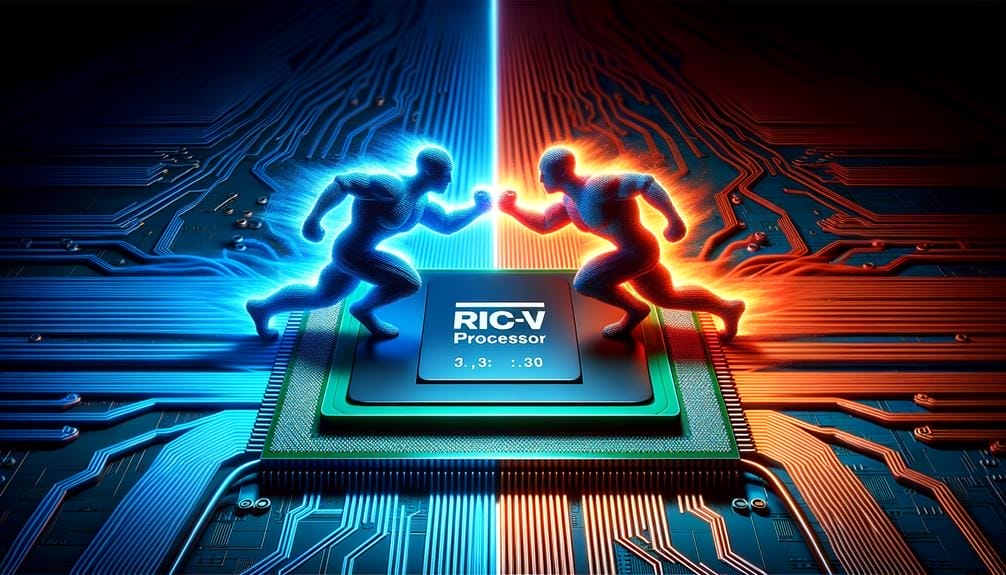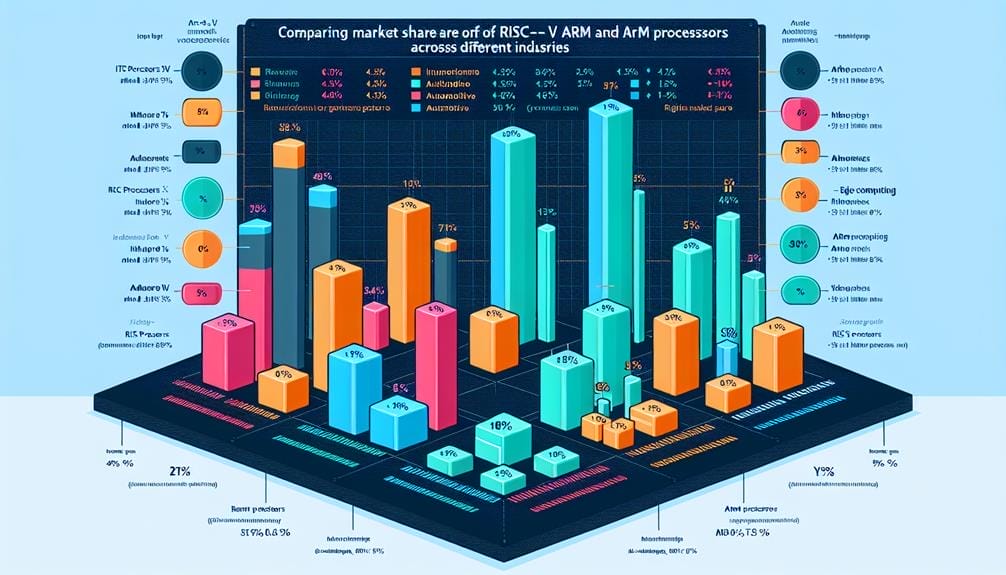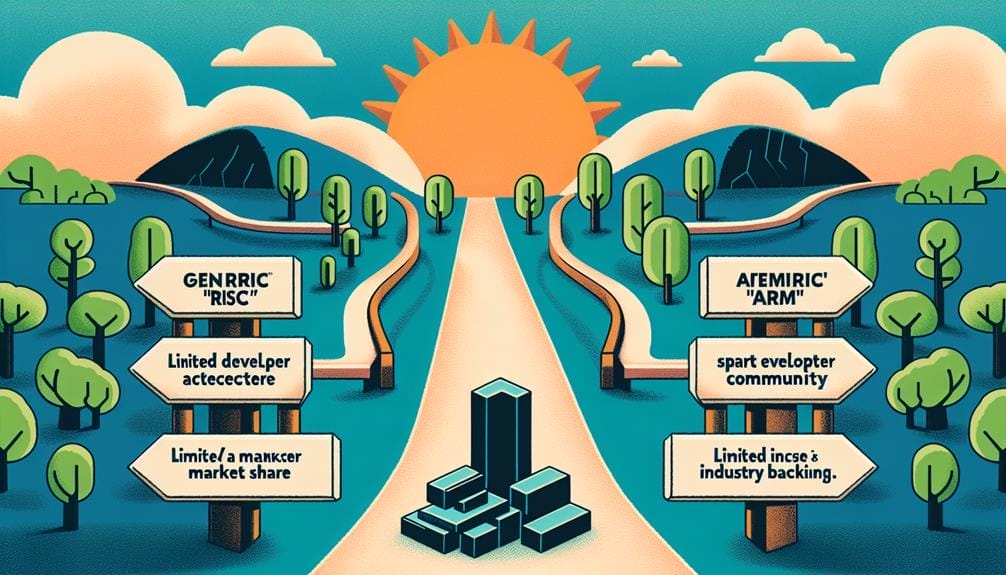RISC-V Challenges ARM's Tech Supremacy

Recent advances in minimalist architecture for computer processors, particularly RISC, have ignited an intriguing competition. Nowadays, RISC-V is emerging as a formidable competitor, posing a challenge to ARM’s extended dominance in the technology sector. This transition signifies a significant shift within the industry and prompts important inquiries regarding the future generation of devices and applications that operate on minimal power.
As the rivalry between RISC-V and ARM intensifies, it is imperative to scrutinize the nuanced capabilities, industry adoption, and pricing dynamics of these architectures to understand the full scope of their impact. This analysis will reveal the intricate interplay between these contenders, offering valuable insights into the evolving technological landscape and its implications for consumers and developers alike.
Key Takeaways
- RISC-V is a competing RISC architecture that offers no licensing fees and allows for custom CPUs.
- ARM processors have a long history of optimization and refinement, resulting in excellent performance and power efficiency.
- RISC-V devices can be made and sold for cheaper than ARM devices due to no licensing fees.
- The future success of RISC-V will depend on gaining mainstream support from major operating systems.
RISC-V's Advantages and Features

RISC-V's open-source architecture and absence of licensing fees offer a compelling advantage, fostering innovation and customization in CPU design. This open-source potential allows for greater transparency and collaboration, driving the development of diverse and specialized embedded systems.
With RISC-V, developers have the flexibility to tailor CPU designs to specific application requirements, leading to more efficient and cost-effective solutions for embedded systems. The absence of licensing fees further enhances RISC-V's appeal, making it an attractive option for manufacturers looking to reduce production costs for embedded systems.
As the industry continues to embrace the Internet of Things (IoT) and other embedded applications, RISC-V's open-source nature and potential cost savings position it as a strong contender in the embedded systems market, offering a viable alternative to proprietary architectures.
Performance and Customization
The performance and customization capabilities of RISC-V and ARM architectures have significant implications for the development of embedded systems and IoT applications.
ARM processors are known for their excellent performance and power efficiency, having undergone extensive optimization and refinement.
On the other hand, RISC-V processors offer the advantage of customization for specific requirements. However, they may not currently match the same level of optimization and support as ARM processors.
Additionally, the developer community for RISC-V is steadily growing, contributing to the evolution and enhancement of RISC-V's capabilities.
As the industry continues to evolve, power efficiency comparison and the ability to customize processors will play a crucial role in determining the most suitable architecture for various embedded systems and IoT applications.
Industry Adoption and Support

Gaining momentum across various industries, the adoption and support of RISC-V architecture are becoming increasingly notable. RISC-V's impact on the semiconductor industry is significant, with growing support from established companies and startups.
However, challenges persist in gaining mainstream support, particularly in competing with the well-established ARM architecture. While RISC-V offers cost advantages and customizability, ARM's overwhelming support from manufacturers and its extensive ecosystem pose hurdles for RISC-V. The ongoing development of operating systems and software also affects the visibility of RISC-V's pricing advantages.
Nevertheless, RISC-V's open-source nature and potential cost savings make it attractive for embedded systems and IoT applications. The future success of RISC-V hinges on overcoming these challenges and gaining broader industry adoption.
Pricing and Licensing Comparison
Amid the ongoing competition between RISC-V and ARM architectures, a noteworthy contrast emerges in their pricing and licensing models.
- RISC-V cost advantage is significant, as it eliminates the licensing fees associated with ARM architectures.
- ARM licensing fees can be substantial, potentially impacting the overall cost of devices built on this architecture.
- RISC-V's pricing advantages may not be fully realized due to the ongoing development of operating systems and software.
- RISC-V's open-source nature allows for greater transparency and collaboration, providing potential benefits in licensing and development costs.
- China and Russia are accelerating their own RISC-V production due to its cost advantage.
Market Outlook and Potential

The market outlook and potential for RISC-V architecture demonstrate a disruptive force in the industry. This is particularly evident in its competitive pricing and licensing advantages compared to ARM. RISC-V's open-source nature and potential cost savings make it an attractive option for future applications. This is especially true in embedded systems and IoT.
The market growth for RISC-V is evident. China and Russia are accelerating their RISC-V production due to its cost advantage. Despite ARM's dominance in the mobile device market, RISC-V has the potential to offer cheaper devices and its open-source nature may lead to increased industry adoption.
The future success of RISC-V will depend on gaining mainstream support from major operating systems. As the competition between RISC-V and ARM continues, it will drive innovation and provide more options for consumers and developers.
RISC-V Vs. ARM: Innovation Battle
In the ongoing competition between RISC-V and ARM, the battle for innovation is shaping the future of processor architectures in the technology industry. Both RISC-V and ARM are driving significant advancements, impacting the semiconductor industry and potential applications in the automotive sector.
RISC-V's open-source nature fosters collaboration and transparency, potentially reshaping semiconductor industry dynamics. ARM's long history of optimization and refinement in processor architectures has led to significant impact on the semiconductor industry.
RISC-V's customizable nature may open up new possibilities for automotive applications, allowing for tailored solutions in the sector. ARM's dominance in the mobile device market has influenced its impact on the automotive sector, providing a strong foundation for potential applications.
The competition between RISC-V and ARM is fostering innovation, ultimately benefiting the semiconductor industry and the automotive sector.
Addressing RISC-V Challenges

The competitive landscape between RISC-V and ARM, driven by their respective technological innovations, has prompted a focused examination of how RISC-V can successfully address its current challenges to solidify its position in the semiconductor industry. Overcoming barriers such as limited optimization and support is crucial for RISC-V to meet industry demands and gain mainstream acceptance. To achieve this, RISC-V needs to focus on refining its processors for improved performance and power efficiency, while also expanding its ecosystem and developer support. Additionally, addressing the ongoing development of operating systems and software to fully leverage its pricing advantages will be essential. The table below provides a comparative analysis of the current challenges faced by RISC-V and potential strategies to address them.
| Challenges | Strategies |
|---|---|
| Limited optimization | Enhance processor optimization |
| Lack of developer support | Expand developer support and tools |
| Emerging ecosystem | Strengthen alliances and industry partnerships |
Conclusion
In conclusion, the emergence of RISC-V as a competitor to ARM's dominance in the reduced instruction set architectures (RISC) landscape has significant implications for the tech industry.
RISC-V's advantages in performance, customization, industry adoption, and pricing dynamics pose a notable challenge to ARM's established supremacy.
As these architectures continue to evolve, the rivalry between RISC-V and ARM will shape the trajectory of innovation and choice for consumers and developers, driving the technological landscape forward.

